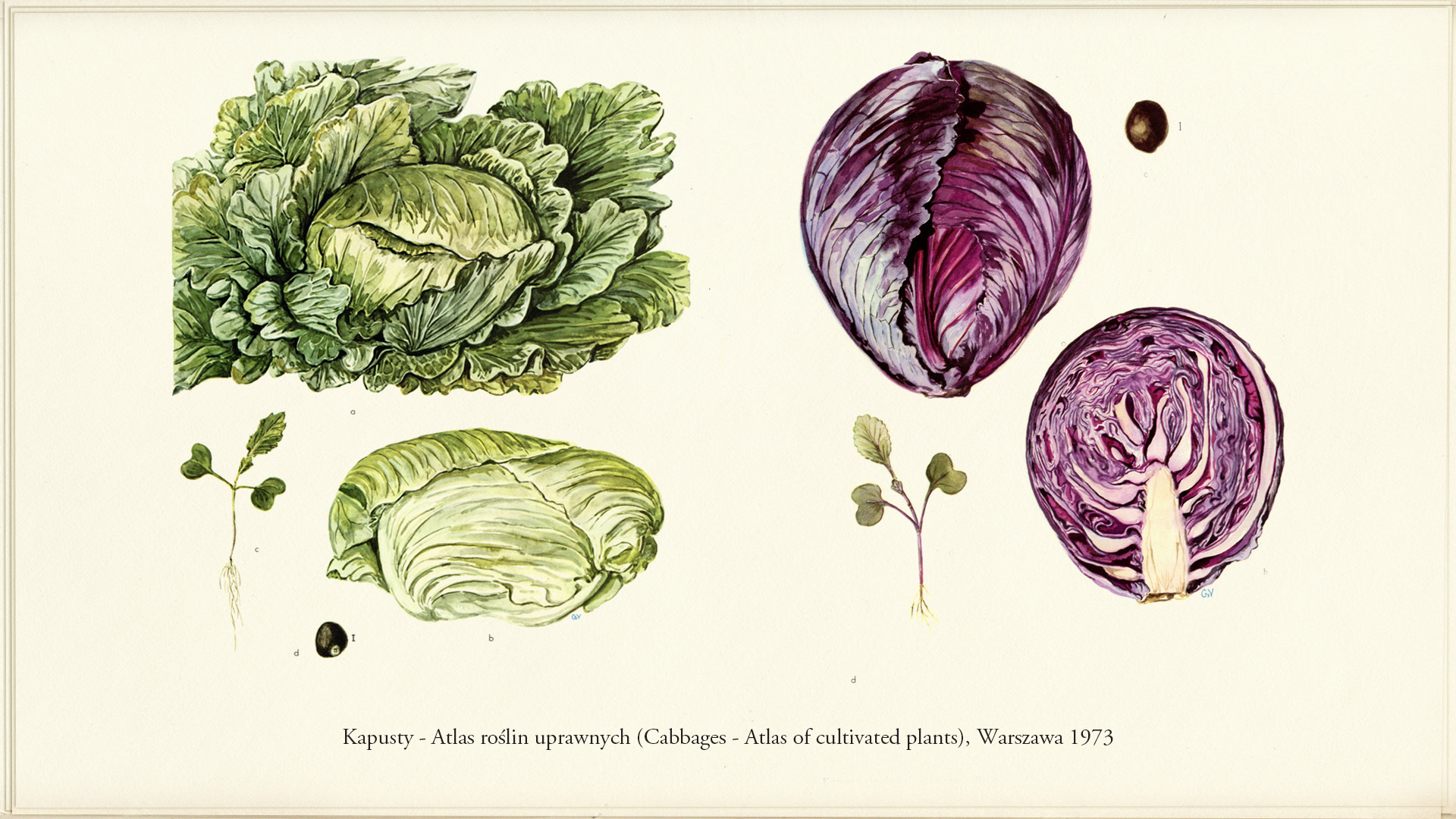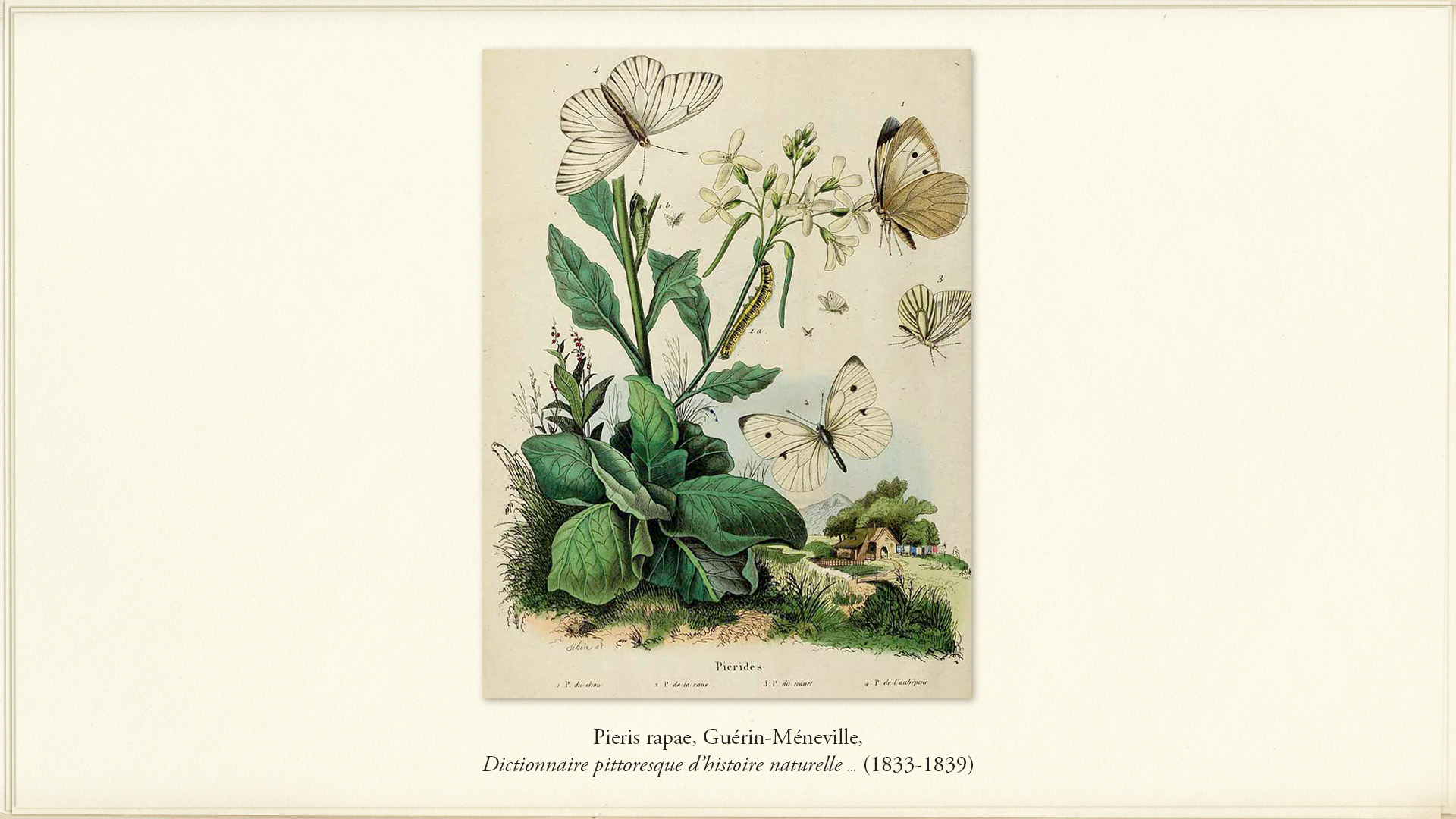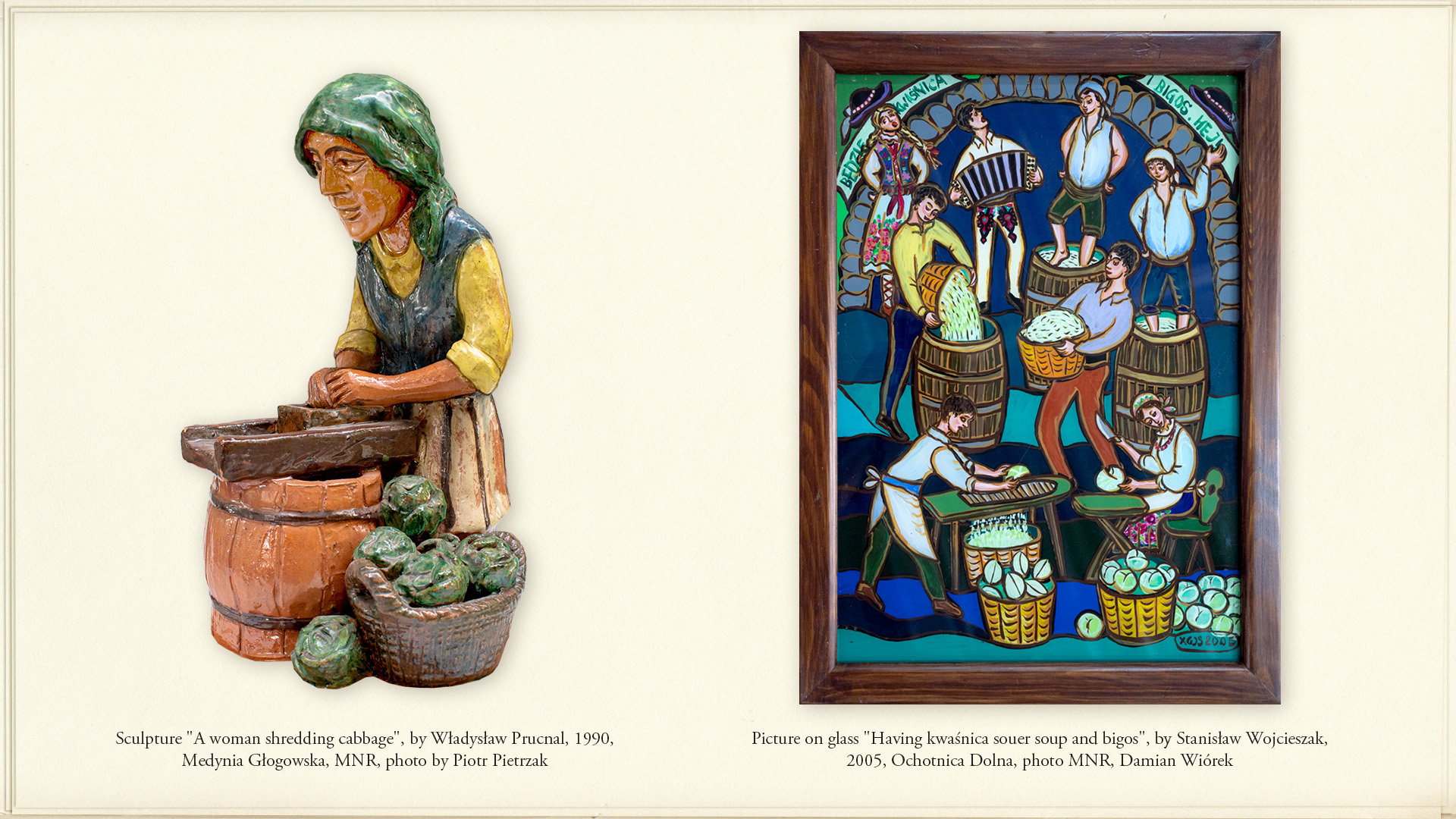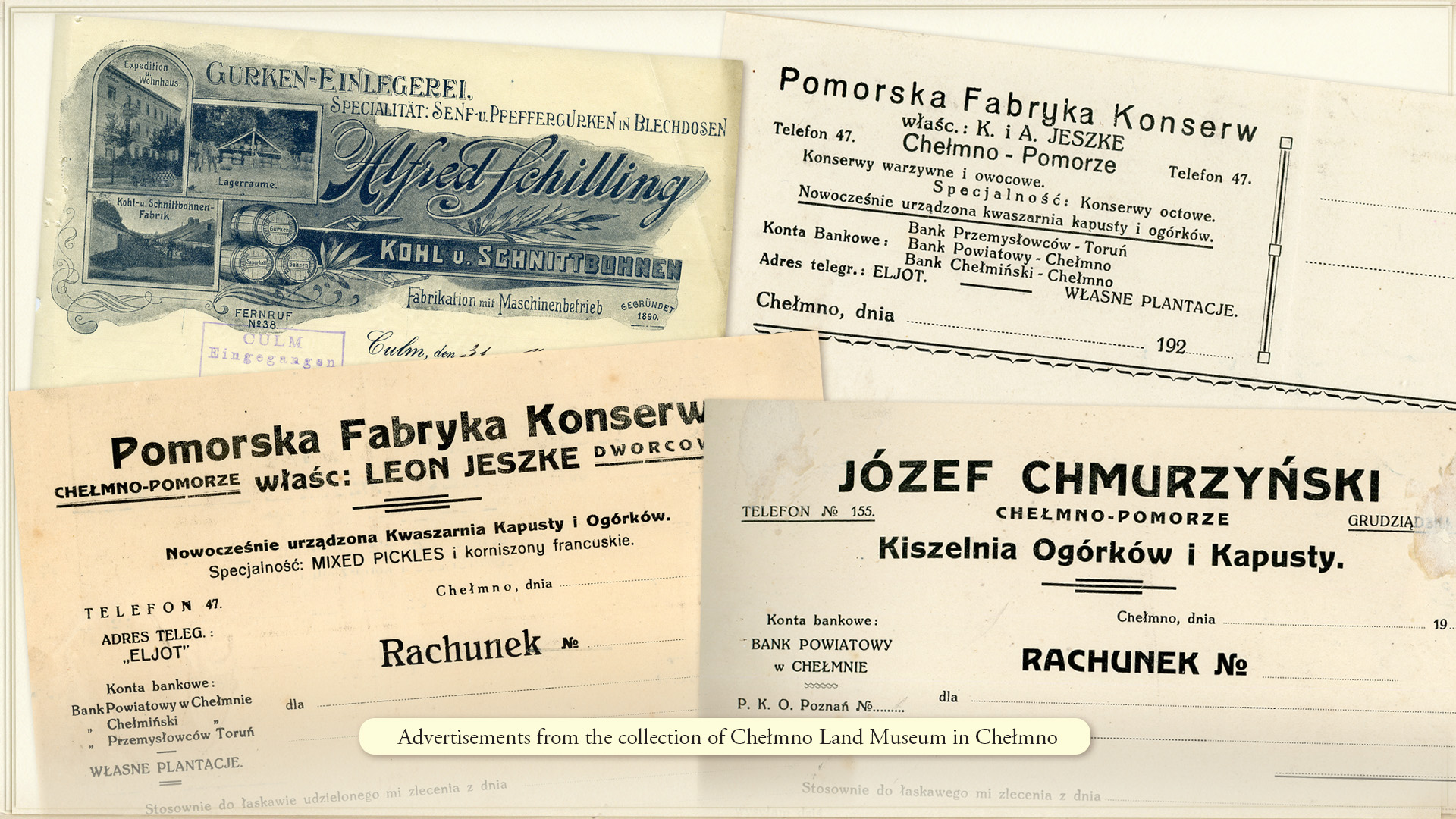
All varieties of cabbage plants, including: cabbage lettuce (white, red, savoy), kale, Brussels sprout, Chinese cabbage, cauliflower, kohlrabi, come from wild cabbage which grows in the Mediterranean Sea area. The most well-known and useful species of this family is white cabbage.
In Northern Europe, the cultivation of this cabbage was initiated by the ancient Celts and Germans. The beginnings of the cultivation of this vegetable and its use in cuisine in Poland date back to the turn of the 14th and 15th centuries, which is confirmed by written medieval sources.
Special vegetable gardens, called “kapustniki” [cabbage plots], were often designated for growing cabbage, usually located in a damp place. It was also grown in ordinary gardens, among other vegetables. Two varieties were known at that time – “white” and “black” (now known as red).
When cabbage became widespread in our country it was grown both in manor and peasant gardens, in fields and on suburban horticultural farms specializing in growing vegetables. Thanks to the development of horticulture over the centuries the cultivation of this vegetable has improved and various native varieties have appeared, for example: Świętojańska, Majowa, Lipcówka, Pomorska, Wolska (grown by gardeners from Warsaw region) or Kamienna Głowa, a variety still known today. Species sown from seeds imported from abroad were also cultivated, such as: Brunswick, Finland, Magdeburg, Swedish Late and American varieties: Colombian, Queen of Autumn, Amager.
White cabbage was appreciated not only for its taste and health benefits but also for being perfect for preserving in bulk. Aleksander Kisielewski, author of the gardening guide entitled Walks in the Field and Garden from 1850, wrote about cabbage: Cabbage without seasoning or fat is not a very nutritious dish, but it is healthy when eaten sweet, dilutes the moods and makes digestion easier.
White cabbage is a biennial plant. For consumption purposes it is used as an annual vegetable. It is composed of a root, a stem – the core, and an apical bud – the head, composed of spirally growing leaves arranged in many layers. Cabbage leaves are large, stiff, various shades of green and covered with a waxy coating. Flower shoots, which produce seeds, grow in the second year of cultivation. Cabbage grows best on fertile soils: clay soils rich in humus, alluvial soils, loess and black earth. Favourable natural and climatic conditions and the appropriate quality of arable land have meant that in the Kuyavian-Pomeranian Voivodeship, the cultivation of white cabbage has been widespread for several centuries, especially in Kuyavia and Chełmno Land.
Cabbage is divided into early, medium early, medium late and late varieties, depending on its vegetation period and harvest date. It can be grown from seeds sown directly into the ground or – which is more common in Poland – from seedlings. Seedlings are planted, depending on the variety, from April to mid-June. Cabbage is harvested from early June to late October/early November. The usable part of this vegetable is the head weighing from 1 to 8 kg, which may be ball-shaped, egg-shaped or flattened.
This vegetable is characterized by a high content of carbohydrates and dietary fiber. It is rich in minerals (potassium, calcium, phosphorus) and vitamins. It has antibacterial, antioxidant, cleansing, memory-enhancing, anti-inflammatory, diuretic, antiseptic, healing, anti-ulcer and regenerative properties. It is low in calories, but stewed in fat makes it hard to digest, so it is worth seasoning it with cumin, marjoram and savory, which will make it more delicate. Gives a long-lasting feeling of satiety.
Apart from peas, swede and turnips, and from the end of the 19th century also potatoes, white cabbage was the main food of old-time village inhabitants in all regions of Poland. It was eaten all year round – on weekdays and on holidays – and in various forms: thick, runny, in combination with: potatoes, legumes, groats or without any additives, with bacon backfat, lard, and during time of fasting with oil.
On peasant farms people prepared supplies of this vegetable for the winter. Even those who did not have their own land took a field from a rich peasant, for later working of, and planted cabbage. When there was a poor harvest of cabbage, depending on financial possibilities, it was bought at the market. In winter, cabbage heads were stored in cellars but most often they were used to make supplies in the form of sour cabbage. A famous proverb said: A farmer without peas and cabbage has an empty belly.
Since cabbage was such an important part of the diet for the rural population in the past, people tried to ensure its good harvest in every possible way. Therefore, its cultivation was once associated with numerous practices, not only gardening and agricultural, but also those of a ritual and magical nature. Even in winter, carol singers would extend their wishes for a good harvest to the farmers by singing:
For happiness, for health, for this New Year
May cabbage and peas grow here for you.
Applying various procedures, attempts were made to influence the yield of the vegetable, its growth, and to protect it from pests. In Pomerania, it was believed that there would be a good harvest if cabbage seedlings were sown on the Feast of the Annunciation of the Blessed Virgin Mary – Our Lady of the Annunciation (25th of March). In Kujawy, women were careful not to plant cabbage during their periods “because the cabbage would not yield”. To protect the crops from caterpillars, palms blessed on Palm Sunday were burned on the cabbage beds, eggshells from blessed eggs were scattered, and herbs blessed on the Feast of Our Lady of the Herbs (15th of August were scattered. Hemp was sown between cabbage seedlings, the smell of which was supposed to repel caterpillars.
Cabbage was also used in old-time medicine and traditional folk healing. It was called the “poor people’s doctor.” In Kujawy, cabbage leaf compresses were used to treat headaches and dizziness, and fresh cabbage juice was used to treat tuberculosis, agnail (purulent finger infection) and worms in children. Rev. Krzysztof Kluk in Dykcyonarz roślinny [The Plant Dictionary], a book from the year 1887, recommended: Fresh leaves dipped in warm water and applied to the head relieve the pain from hangover. Fresh leaves also heal putrid wounds and ulcers.
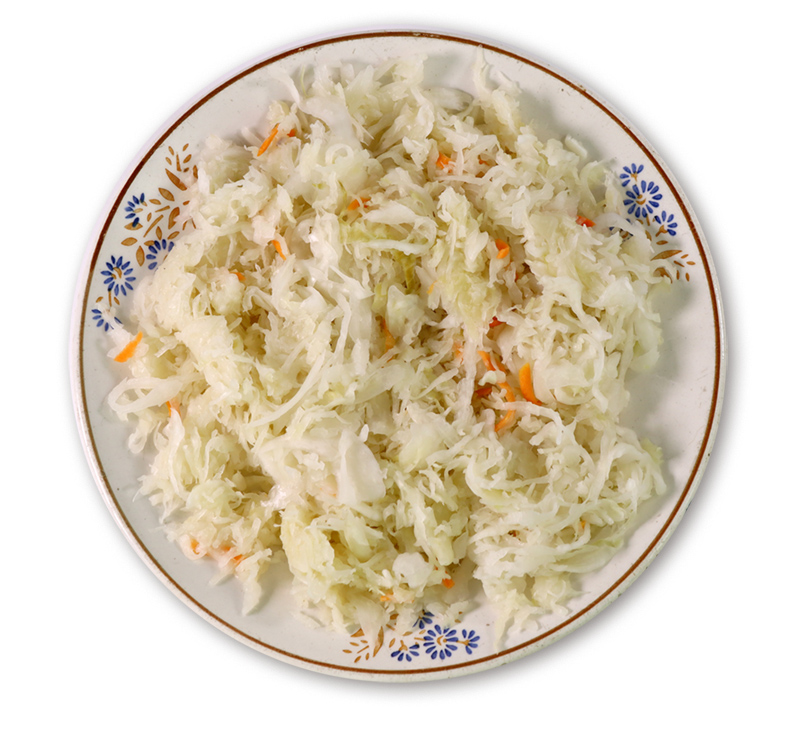

Making sauerkraut
Fermenting cabbage was and is currently the most common method of preserving it. During this process, fermentation occurs, which produces lactic acid, which fixes the cabbage and helps preserve the vitamins in it.
In old rural cuisine, sauerkraut played an important role because, like fresh cabbage, it was the basis of everyday and holiday dishes. Each family prepared large supplies, depending on their wealth and the number of household members, so that there would be enough yet for the early spring season. Usually several barrels of cabbage were made for the winter.
The method of fermenting cabbage was similar in most regions. However, additives and spices differed, as it depended on the family’s taste preferences or local culinary traditions. In some regions, for fermentation used was cabbage harvested after the first frost; it was supposed to be sweeter if harvested at that time and would ferment better. People believed that the best cabbage was “hard” and “creaky”, and it was best when it was pickled during the new moon.
The cabbage was fermented in barrels, usually made of oak, which were well soaked, washed and carefully scalded before use. Leaking barrels were sealed from the outside with resin and inside with hard-kneaded rye flour dough.
Cabbage heads were peeled of dirty and damaged leaves, divided into halves, the core was removed and finely chopped with a knife, a special chopper or a cleaver. This work was improved over time by shredding machines,
Trampling down the cabbage, a fragment of the show Making saurkraft in Kuyavia region (Kujawy) performed by groups “Śmiłowiónki” and “Ziemia Kujawska” Recorded at Choceń Cultural Center – Library, Choceń 2024.
Cabbage shredding, a fragment of the show Making saurkraft in Kuyavia region (Kujawy) performed by groups “Śmiłowiónki” and “Ziemia Kujawska” Recorded at Choceń Cultural Center – Library, Choceń 2024.
Snacks, a fragment of the show Making saurkraft in Kuyavia region (Kujawy) performed by groups “Śmiłowiónki” and “Ziemia Kujawska” Recorded at Choceń Cultural Center – Library, Choceń 2024.
which became widespread in villages at the turn of the 19th and 20th century. The bottom of the barrel was covered with cabbage leaves and chopped cabbage was placed on top, each layer being trampled or beaten with a wooden mallet. It was salted in two ways: the entire portion, after chopping, was mixed with salt before putting into the barrel, or salt was sprinkled on each compacted layer. To diversify the taste, and according to preferences, the following were added: caraway seeds, dill seeds, juniper berries, bay leaves, cranberries, blueberries, sliced carrots, whole apples.
After filling the barrel and tamping down the cabbage, a clean piece of cloth and a scalded wooden disc (it could not have any nails) were placed on top which was pressed down with a scalded, heavy stone (it could not
The objects come from the collections of Maria Znamierowska-Prüffer Ethnographic Museum in Toruń (MET)
and the National Museum of Agriculture and Agro-Food Industry in Szreniawa (MNR)
be made of limestone). After 2-3 days, a wooden peg was used to pierce a hole in the cabbage to the very bottom to eliminate the unpleasant smell of fermentation. This procedure was repeated every couple of days. At that time, barrels of cabbage stood in a warm room. The barrels were then moved to a cooler place. They were checked from time to time, and when mold appeared on the surface, the cloth, disc, and stone were scalded with boiling water. Careful attention paid while fermenting the cabbage ensured that supplies would last until
spring. Cabbage was also fermented in stoneware vessels which became popular in villages at the beginning of the 20th century, and later also in glass jars.
Supplies of sauerkraut were also prepared in urban households. At that time, there were persons hired who went from house to house in the autumn with their own chopping equipment and offered their services. There were also processing plants specializing in the production of pickled products. Examples of such companies which operated in the first half of the 20th century in Chełmno included: Józef Chmurzyński’s cabbage and cucumber pickling company or the Pomeranian Cabbage and Cucumber Preserving Factory.
Making sauerkraut has a long tradition in Polish folk culture with many customary and characteristic features. In the past, it was a custom of helping one’s neighbours (communal work), and it was not appropriate to refuse help, then neighbours who offered their help expected to receive assistance when they needed it. This communal work was carried out by members of the household and people specially invited by farmers. Mainly women and young people gathered in the house where the cabbage was to be chopped. Housewives prepared refreshments for that day. There was also no shortage of alcohol, mainly vodka. The joint work was accompanied by games, telling stories, gossiping, and singing songs and chants related to the topic of chopping cabbage. Often after work there was a party with music and dancing.
In traditional rural cuisine, sauerkraut was widely used. Sauerkraut juice was also used to prepare meals. Sauerkraut was eaten cooked thick or thin, in various combinations. It was most often served with potatoes, but could be eaten plain or with peas, beans, or broad beans. Sauerkraut was also cooked with barley groats. And various types of fat was added to it. Sauerkraut was used to stuff dumplings and cabbage rolls. It was also the base for dishes such as cabbage soup or bigos. It was most often eaten for dinner, but it was also served for breakfast and, less often, for supper. In autumn and winter, sauerkraut was cooked for meals almost every day, and if there was enough left, also in spring. Juice from sauerkraut was added to enhance the flavour of some dishes. After boiling it and seasoning with flour, it was eaten with potatoes or dumplings.
Sauerkraut was an obligatory part of dishes served for Christmas Eve supper. Back then, it was eaten with dried mushrooms or with onion and pepper, and it was added as filling to pierogi (dumplings). At weddings, guests were served well-greased cabbage without peas or with peas, and in wealthier households with meat. Sauerkraut is now included on the list of traditional Polish dishes.
Like fresh cabbage, sauerkraut was also used in medicine and rural healing. Sauerkraut juice was considered a healthy, energizing drink that also improved appetite and digestion. Sauerkraut juice was used to treat inflammation of the oral cavity, stomach ulcers, pain in the limbs and many other ailments. It was also considered a very effective hangover reliever. Sauerkraut compresses were recommended for frostbite and fever.
When taken sour, it is much more healthy because its acidity kills worms and cleans the skin of sediment that settles from other bland dishes, due to which it is recommended to people on ships (…) to avoid the weakness called scurvy, wrote Aleksander Kisielewski in his guide entitled Przechadzki po polu i ogrodzie (Wanders in the Field and Garden) from 1850.


